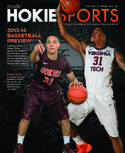The compliance corner answers questions concerning the governance of intercollegiate athletics and its impact on our athletics department. Have a question? Please send it to inside@hokiesports.com and we’ll answer it in upcoming issues.
Now, here are a couple of questions that we’ve received from Tech alums and fans over the past few months, with responses from Tim Parker, Associate AD for Compliance & Governance:
Q: I keep seeing conflicting reports about Antone Exum’s chances at getting a medical redshirt. Some are saying that he has a chance, but I didn’t think that was the case because Tariq Edwards couldn’t get one last year. Can you please clear this up? Thanks, Kent in Pearisburg, Va.
TP: “You are the one who is correct. This is a topic we’ve addressed before, but it is confusing, so I’ll come at it from a different angle. The key question is: Even if he does qualify for a medical redshirt this year, will he get the chance to use it?
“All student-athletes entering an NCAA Division I school have five years within which to compete during four seasons. To have the chance to compete during a sixth year, a student-athlete has to miss all or most of two seasons for circumstances beyond his/her control. It could be related to injuries, or maybe missing seasons because of an illness in the family – something like that.
“A traditional redshirt year – during which a student-athlete who otherwise could compete refrains from competition – does not constitute a circumstance beyond one’s control. As viewed by the NCAA rules, a student-athlete elects to redshirt, even though it’s nearly always at the encouragement of the coaching staff. An overwhelming majority of the time, a redshirt year is justified and beneficial to the student-athlete because it allows him or her to get bigger and stronger and more mature, and to adjust to college academics without the pressure of competing.
“But again, by the NCAA’s definition, a redshirt year is not beyond one’s control. So in Antone’s case and in Tariq’s case, neither would be able to receive a sixth year based on their current collegiate histories. Both engaged in a traditional redshirt year in 2009, and did not miss that season due to circumstances beyond their control.”
Q: Does the NCAA allow student-athletes to endorse a product as long as they don’t get paid? For example, if I wanted to get Logan Thomas to endorse my new clothing line, could he do it as long as he didn’t get paid by me? Thanks, Jack in Christiansburg.
TP: “No, he couldn’t. Even if he didn’t receive compensation, he couldn’t do it. NCAA regulations forbid expressly or implicitly endorsing commercial products or services. The penalty for violating this rule is loss of eligibility.
“However, if you wanted to employ a student-athlete, that is permissible as long as the student-athlete is paid the going rate in that locality for similar work. The compensation cannot include an increased amount due to his/her athletics reputation. Student-athletes who engage in employment are required to fill out some paperwork here in the compliance office, which we keep on file.”
Q: I’ve heard that Virginia Tech football players who play well in games that the Hokies win actually receive a game ball. Wouldn’t that be an extra benefit and constitute a violation? Thanks, Amber in Philadelphia.
TP: “Historically, the provision of game balls has been viewed as a violation of NCAA Bylaw 16.1.4, which states that, ‘awards for specialized performances in a single contest may only be provided by the conference and an outside organization (e.g., local business) and must be a certificate, medal or plaque limited to $80 in value.’
“However, the NCAA staff this September released a memo clarifying that, ‘an institution may provide a memento of nominal value (e.g., game ball, t-shirt, hat, etc.), which may not include cash or cash equivalents, to a student-athlete in recognition of an accomplishment in a particular contest or event as a benefit incidental to participation.’
“So, game balls are now permissible. Student-athletes, though, are not allowed to sell any items received from their respective athletics departments. Some have in the past (e.g. Ohio State) and it can result in a boatload of trouble.”
Q: When can a high school prospect starting taking official visits? Thanks, Heather in Blacksburg.
TP: “Prospective student-athletes in all sports except basketball cannot take an ‘official visit’ (a visit for which the recruiting school pays some or all expenses), until the opening day of classes during their senior year in high school. In men’s basketball, though, prospective student-athletes can start taking official visits after Jan. 1 of their junior year. In women’s basketball, prospective student-athletes cannot take official visits until the Thursday after the NCAA Division I national championship game during their junior year of high school.
“Rules allowing for earlier official visits in men’s and women’s basketball were adopted in an attempt to emphasize relationship-building between college coaches and prospects, while also limiting the influence of third parties (specifically, shady AAU coaches) on the recruiting process.”




